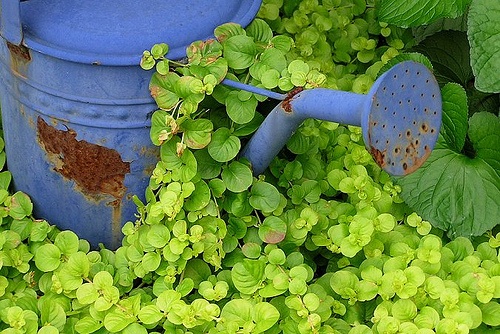
Photo credit: Lindley Ashline via Flickr
It’s springtime in the northern hemisphere, time to plant the seeds and seedlings that, through summer and fall, will produce a lush garden and a rich harvest.
Self-employment has seasons, too. When spring arrives in your business, you are drawn to plunge your hands into the rich soil of the work you love. You are captivated by the possibilities, searching through the seed catalogues of home study courses, live workshops, free telesummits, and virtual programs, all with the potential to begin or renew your business.
But sometimes enthusiasm over all this promise shades over into a kind of eager desperation. You don’t want to miss out on any of the abundant possibilities.
And sometimes it’s a false spring. Spurred by anxiety, feelings of inadequacy, or even confusion, you find yourself reaching for one more audio, one more book, one more membership program.
And before you know it, your hard drive is full of more mp3s than you can possibly listen to in a lifetime on the treadmill or the trail. You’ve downloaded enough PDFs to start your own business library. And your inbox overflows with e-courses, newsletters, offers, and announcements.
It’s good stuff. But just as you can over plant a garden, you can suffocate yourself and your business with too much inspiration, information, and guidance.
Even in spring, a gardener needs to pull weeds, thin seedlings, root out invasive perennials. And when it comes to growing your business, you need to do the same so that your investments of time, energy, and money actually bear fruit.
Here are a few guidelines for getting your garden under control when, for whatever reason, it’s overgrown.
Name the problem. Realize it’s not temporary.
You can’t solve a problem until you recognize it. And you won’t solve it as long as you imagine it will go away. Take a good hard look at your information garden. Is it thriving or overgrown? If the latter, realize it will only get worse unless you take action.
Put emails from all the lists you are on into one folder.
If you’ve let email pile up in your inbox, move everything from a mailing list into a single LISTS folder.
Make a YES list.
Sort your LIST folder by the sender’s email address. That way all the email from one sender will be grouped together.
Look through the emails and choose no more than five lists to stay on (three is better). This is your YES list.
Unsubscribe.
Unsubscribe from every list that is not on your YES list. Do the same as new emails arrive. (Don’t be surprised if it takes you a few weeks to get off all the extraneous lists.)
Delete, delete, delete.
Delete everything that is not on your YES list. Delete everything that is more than 30 days old, even if it is on your YES list.
Clear your virtual desktop.
Group the mp3s, PDFs, and related files from your YES list into a single LEARNING folder. Create subfolders for each course or program.
Delete everything that doesn’t qualify for your LEARNING folder.
You can’t possibly listen to or read all the information you’ve collected. Move everything that doesn’t qualify for your LEARNING folder to the recycle bin. If you can’t bear to part with something, collect the mp3s into a LISTENING folder and PDFs into a READING folder.
Make a learning plan.
Every month review your LEARNING folder. Decide which materials are immediately relevant to your business. Schedule time in your calendar to work through them and apply what you learn to your business. It doesn’t matter how smart you are if you don’t put that information to use.
Continue to cull extraneous files.
Every three months review your READING and LISTENING folders. Delete the recordings and documents that you haven’t used in the previous 90 days. If you’ve paid for a program and can’t bear to delete it, go ahead and keep it for now. But sooner or later you’ll be better off without it rather than letting it drag you down with guilt.
Take heart.
When you first follow this plan you may feel like you are wasting valuable resources. But these days information is retrievable and replaceable with a few keystrokes. Anything you truly need will be available again from the same or a different source.
Remember, if resources were abundant enough to overtake your garden, they’re not likely to disappear just because you take charge.
Back to the garden.
Gardening is a fundamentally creative and restorative act. When the weeding and culling are done, you’ll be able to see your garden clearly. You’ll have a clear view of the most important plants to tend. You’ll have the resources to water and feed them. You’ll have time to enjoy the process until the eventual harvest.

